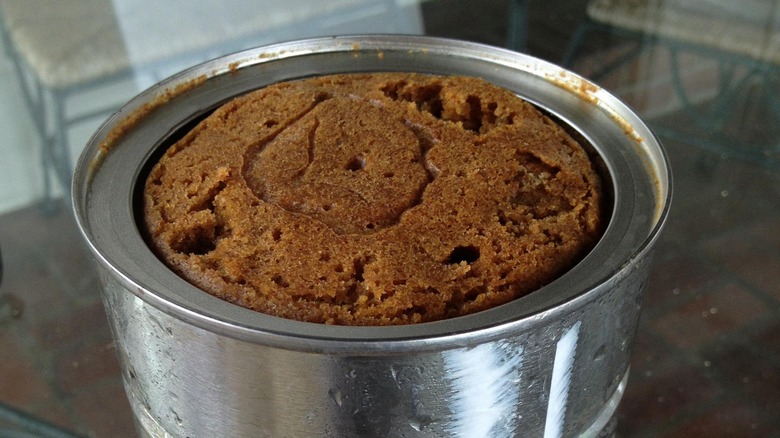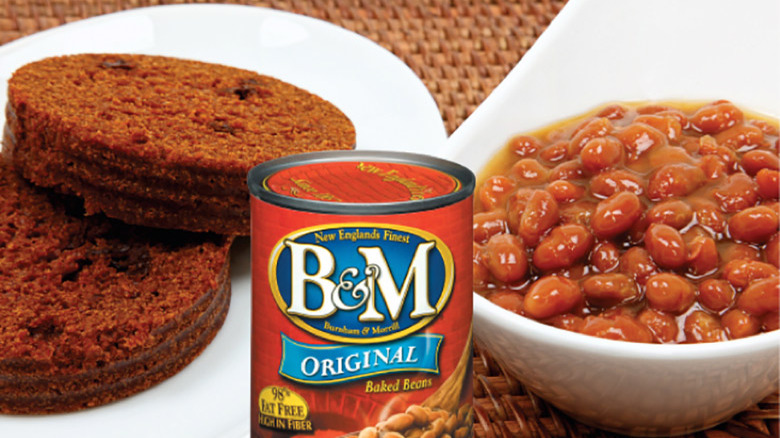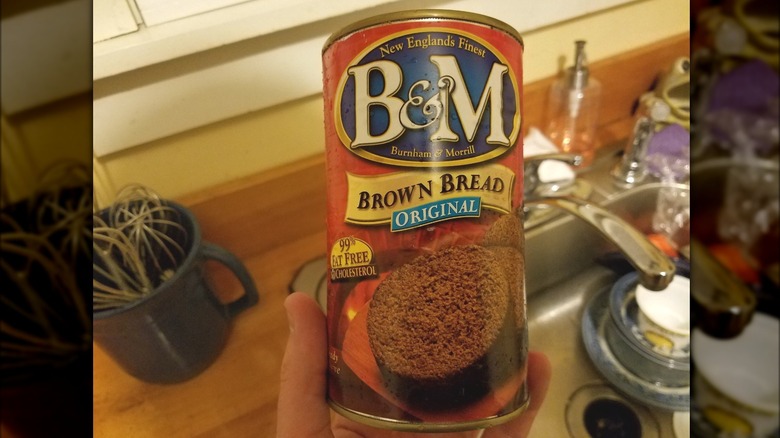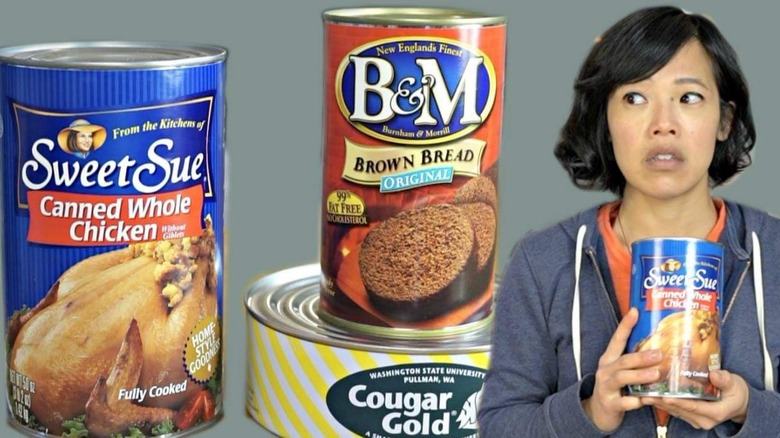The Truth About Canned Bread
Unless you're from New England, the idea of canned bread probably sounds really, really odd. Bread is supposed to be something that's fresh from the baker's oven, right? And if it's stored at all, it's typically wrapped in plastic, not encased in a can. You're not likely to see canned goods in the bread aisle of your local grocery store, but canned bread is actually a thing.
Who exactly had the bright idea of putting bread in a can, anyway? It turns out, we can look to colonial New Englanders for that answer. Commonly known as Boston brown bread, it's believed to have been created by early Americans with rye and cornmeal, and it was steamed, rather than baked in an oven, simply because ovens weren't always available, per The Chicago Tribune. Some bakers added molasses to give it a better taste, and, yes, it was actually cooked in a can.
According to New England Today, by the mid-1800s, canned meats and veggies were popular items, and Burnham & Morrill (a.k.a. B&M) was doing good business in New England. B&M eventually began selling canned brown bread, and the company still sells it today.
What does canned bread taste like?
The big question all you non-Yankees are undoubtedly wondering is, "What does canned bread taste like?"
While it may not look particularly appetizing with its rings around the edges, similar to a cylinder of canned cranberry sauce, it has a somewhat sweet taste because of the molasses, and has a crumbly texture similar to a bran muffin. Sometimes, it might include raisins for added sweetness, and while it's probably not ideal for a sandwich, cream cheese, jam, and butter are popular spreads. Some people prefer to serve it hot with a side of beans and franks.
Canned bread is one of those foods where if you grew up eating it, then it probably holds a special place in your heart. If not, it very well might taste about as good as it looks. "That's not very good at all," said one YouTube review. "There's something kind of odd about this. I'm not feeling it," said another reviewer.
How long is canned bread good for?
Canned foods are known for having very long shelf lives, but what about canned bread? Does it have the same impressive lifespan as canned fruits and meats? As the research shows, if a food is in a can, it can hang around for quite a while. Travel Food Atlas, for instance, claims that canned bread has a shelf life for up to 2 years, while Skilled Survival says that canned bread can last far longer than 2 years — up to 10 years, in fact, provided the can isn't damaged. Put simply, while your loaf of bread from the supermarket may go moldy in a month or two, that can of bread in your pantry will last far, far longer.
But how exactly can canned bread outlive regular bread? The baking process gives us a clue. Atlas Obscura explains that canned bread is made by pouring a cornmeal and molasses "batter" into a can, where it is "steamed until it rises." Unlike bread that is baked and then bagged, which can leave it vulnerable to mold growth, the steaming and canning process helps to ensure that your can of brown bread lasts until you're ready to use it — even if that's years from now.
How to make canned bread at home
In today's world of rising food prices, no one would blame you for wanting to stock up on long-lasting foods. But what if you want to learn how to make canned bread for yourself? Do you need any sort of special tools or equipment, or is it as easy as canning any other foodstuff?
According to Hank Shaw of Simply Recipes, the ingredients for brown bread are remarkably cheap, and include molasses, cornmeal, rye flour, and buttermilk. Your main focus is properly steaming the bread. If you're using your oven, place your batter-filled coffee can or loaf pan into a high-sided roasting pan. Fill the pan with boiling water until it reaches one-third of the way up the container, then place it in the oven. If you're using the stovetop, Shaw suggests placing a steamer rack into a large pot and setting your container on top of it before filling the pot with boiling water the same way you would with the oven method. No matter which method you use, Shaw recommends steaming the bread for 2 hours and 15 minutes, or until a toothpick inserted in the center comes out clean.
Now, if you want to seal your cylindrical creation for later use, that's another thing entirely. According to Skilled Survival, canning your own bread can be risky — it's easy for bacteria to get in, which can lead to dangers like botulism. If you're not planning on eating your homemade brown bread quickly, it's best to leave it to the pros.



